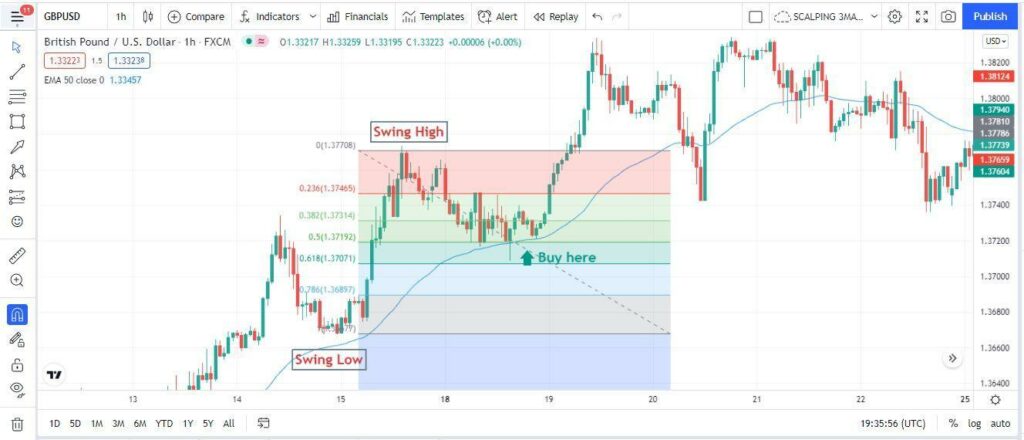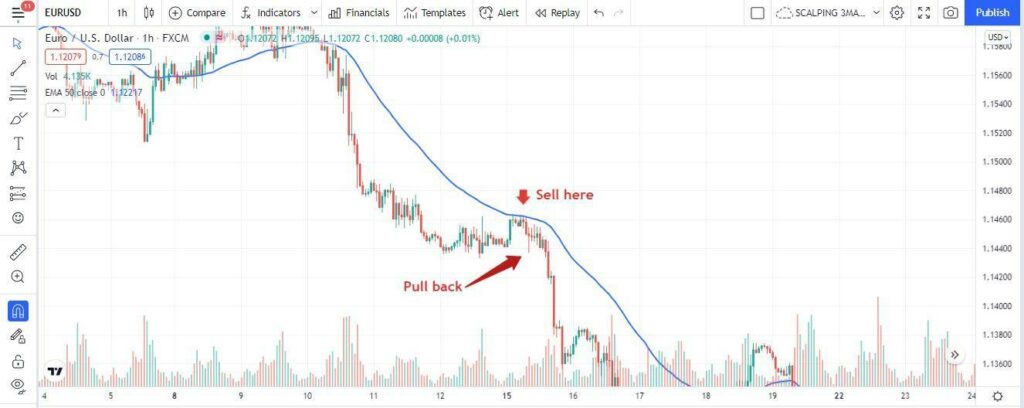Forex and stock marketplace is rapidly expanding as millions of traders exchange currencies and commodities on this platform daily. Correspondingly, traders employ numerous charting techniques and trading strategies to extract profits from this domain.
However, there is no “one defined and fixed successful strategy” suitable for all traders as each one has varied trading styles, equipment, timeframes, and goals. Instead, skillful traders retest and check diverse approaches and pick out the ones best suited to them.
This article has discussed the features, limitations, and examples of pullback strategy, which is among the most simple and profitable trading strategies if appropriately implemented.
What is a pullback trading strategy?
In the trading terminology, pullback refers to the slight movement of the price against the ongoing trend. Price always moves in waves and goes through phases of “price correction” before continuing the prevalent trend.
By trading pullbacks, traders take advantage of the slight price rebound or retracement and enter better positions. Through this strategy, traders capitalize on the current price flow; and wait for a nice retracement for seizing a low-price trade entry.
Moreover, it is essential to note that price usually retracts at various “key levels” such as support or resistance, moving averages, or Fibonacci levels specified by the traders.
How to determine a pullback?
For a strategy to be successful, it is essential to correctly implement it with a pre-defined set of rules. Some traders confuse reversals with pullbacks, although various distinct characteristics set them apart.
A solid directional trend displays weak pullbacks that serve as ideal entry points for traders. If the retracement extent is less with weak candlesticks and low volume, it indicates a weak pullback, resulting in a higher chance of trend resumption.
On the other hand, strong pullbacks can lead to trend reversals or strong market indecision. Usually, strong and consecutive momentum candles with high volume indicate a powerful pullback.
Pullback trading examples
The central idea of pullback trading is to ride the dominant trend by entering at most reasonable positions. There is a wide range of pullback trading strategies that involve retracements to specific levels. The most commonly utilized pullbacks among traders are breakout-pullbacks, moving averages rebound, S&R pullbacks, or Fibonacci retracements.
Here, we have presented two different pullback strategies with a bearish and bullish trading setup.
Bullish trade setup

Firstly, we will determine the ongoing trend of the relevant currency pair. The above GBP/USD chart shows a bullish Fibonacci pullback setup in the 1-hour time frame. We can see a clear rising trend in this trading setup.
You can identify an upward trend if the price moves above the moving averages or a trendline or shows higher highs and higher lows. Moreover, the trend direction becomes clearer on larger timeframes as they exhibit less market noise.
After identifying the price action direction, we would mark the recent swing high and swing low. Next, we would draw the Fibonacci levels from the latest swing low to the swing-high range. The most prominent Fibonacci zones are:
- 32.8%
- 50%
- 61.8%
Afterward, we would wait for the price to retest the 50% or 61.8% level to signal a good pullback system. As seen in the chart, the price dropped to the 50-61.8% zone according to prediction before resuming its bullish trend.
Enter
After confirming the successful price retest from the Fibonacci 50 or 61.8% level, we would enter the trade. Stop-loss can be tightly placed at the level of the previous swing low to get a reasonable risk/reward setup.
Take profit
As we plotted this pullback system on a higher time frame, the targeted profit range is also on the higher side. We would set the TP1 to capture 50 pips, whereas TP2 would target 120 pips from the entry point.
Bearish trade setup

The above EUR/USD chart demonstrates a bearish moving average pullback example in a one-hour time frame. Pullback traders benefit from the existing trend; hence determining the direction of price flow is the first step in this strategy. In the above chart, we can recognize a downtrend with the help of the moving average.
Next, we would identify the strength of a trend. In the above case, the strong bear candles at the start of the trend emphasize the sellers’ market-takeover. Afterward, we would wait for a weak pullback to the 50-EMA level, acting here as a resistance.
Keep note that the pullback should be weak, incorporating a low volume mixture of red and green candles.
Enter
The ideal entry point would be at the price retest on the exponential moving average. The stop-loss position would be tightly above rebound level.
Take profit
This example shows a favorable risk-reward setup that could generate substantial profits with minimal risks. We would take a maximum of our profits at the first signs of the next pullback.
How to make x10 with the pullback trading strategy?
The first rule to extract profits from the pullback strategy is to trade in the direction of the trend. Specify the ongoing trend by using a larger time frame chart interface. Secondly, a conservative entry in the pullback setup is comparatively safer with a lower risk than an aggressive entry.
Thirdly, enter trades with pre-defined rules and candlestick formations. Various candlestick anatomies such as pin bars, engulfing candles, or Doji can serve as entry triggers.
In addition, always follow risk management and keep reasonably tight stop losses to remain profitable in the long run.
Pros & cons
Pullback trading allows the traders to enjoy the momentum of present trends; however, it also has certain limitations.
| Pros | Cons |
| Good risk-reward ratio Pullback strategies provide good reward setups as they usually have a large profit margin. | Risk of reversal The most significant limitation of pullback trading is the risk of price reversal. A pullback can transform into a full-on reversal leading to loss. |
| Along the trend direction Traders feel safe and generate easy profits by trading in the trend direction instead of going against it. | Risk of missing the move Sometimes a pullback to the desired level does not occur. As a result, you could miss the lucrative price move. |
| Better entry Pullbacks allow the traders to enter better positions if they miss the initial move. | Not for aggressive traders Waiting for a pullback requires patience; hence aggressive traders may find it difficult to wait for healthy triggers. |
Final thoughts
Pullback trading strategies are considerably straightforward and have a proven profitability record. Many traders combine other technical tools with this strategy for gaining further trade confirmations and profits.
Moreover, forex and stock markets repeatedly show pullback trading formations, which signify the viability of these setups. However, traders need to maintain a well-disciplined and risk-adjusted approach towards trading for long-term success.